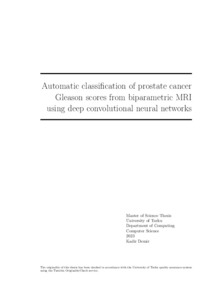Automatic classification of prostate cancer Gleason scores from biparametric MRI using deep convolutional neural networks
Demir, Kadir (2023-06-28)
Automatic classification of prostate cancer Gleason scores from biparametric MRI using deep convolutional neural networks
Demir, Kadir
(28.06.2023)
Julkaisu on tekijänoikeussäännösten alainen. Teosta voi lukea ja tulostaa henkilökohtaista käyttöä varten. Käyttö kaupallisiin tarkoituksiin on kielletty.
avoin
Julkaisun pysyvä osoite on:
https://urn.fi/URN:NBN:fi-fe2023072691610
https://urn.fi/URN:NBN:fi-fe2023072691610
Tiivistelmä
Prostate cancer is one of the most common types of cancer in the world. To reduce the number of deaths caused by it, effective diagnostic methods are of paramount importance to detect the clinically significant cases early enough. The current diagnostic protocols include, among other methods, magnetic resonance imaging which can be used to assess whether a patient suffers from prostate cancer and whether the possible cancer lesions are clinically significant. However, the images are difficult to interpret, and thus the inter-reader reliability is not very good. To address this problem, in this thesis machine learning models are trained to automatically segment and classify prostate cancer lesions from magnetic resonance images. The problem proved to be difficult even for computers, at least with the relatively small data set size. The highest Dice similarity coefficients for the used Gleason score groups approached 0.4, which is not enough to replace the work of professionals or even provide meaningful help for doctors. In conclusion, the task of automatic segmentation and classification of prostate cancer lesions remains an open problem. Improving the performance to a useful level would likely require a noticeably larger dataset or at least a model that better incorporates the knowledge of the trained professionals.
